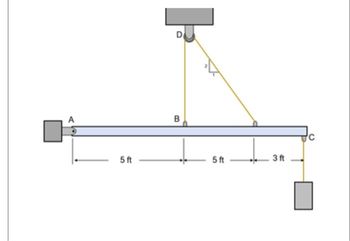Question
Determine the magnitude (in [lb]) of the horizontal reaction on the pin (joint) at A. Consider that there is no friction in the pulley and the cylinder hanging from C weighs 80 [lb].

Transcribed Image Text:5 ft
D
B
5 ft
3 ft
Expert Solution
This question has been solved!
Explore an expertly crafted, step-by-step solution for a thorough understanding of key concepts.
Step by stepSolved in 3 steps with 2 images

Knowledge Booster
Similar questions
- An inclined plane making an angle of 25º with the horizontal has a pulley at its top. A 30kg block on the plane is connected to a freely hanging 20kg block by means of a string passing over the pulley. Compute the distance the 20kg block will fall in 2 second starting from rest. Neglect friction.arrow_forwardFind the answer for the given: Let L be the length. Let M be the mass. A rod that has L and M was hunged from the one end of a frictionless pivot, and it was hanged vertically at rest (intially) A person fired one small ball of clay with mass (m) to the rod with a speed V(initial) and stuck to the end of the non pivoted area. Find the angle Of greatest rotation for the rod/clay system? M M,L V(initial)arrow_forwardThe height varies from h to zero according to this function: y(x) = h ( – 1)´ . The constants h and e replace 1.00 m and 3.00 m. There is also a thickness t and a density p. You need two integrals, the total mass and the center of mass. Possibly surprisingly, you don't actually need the numbers t, h, and p. Ax y(x) X The column at x has a mass Am = (density * volume) = y(x) p t Ax. You add all the Am values to get %3D the total mass M. The sum becomes an integral: М — pt y(x) dx For the center of mass, you add each column's x Am, and divide by M: pt Xc х у(x) dx Calculate xc. The only quantity you'll need is e = 5 m.arrow_forward
- A block of mass mA=20kg on an inclined plane and a bucket of mass mbucket=16kg are attached to the ends of a massless string passing through a massless pulley as shown in the figure below. The inclined plane makes an angle of θ=46o with the horizontal and the coefficients of kinetic and static friction are μk=0.21 and μs=0.58. The system is initially at rest and a student starts to fill the bucket with balls, each of whose mass is 100 grams, one at a time until the system starts to move. Determine the number of balls the student placed in the bucket. Take g=9.80m/s2 and please note that the number balls must be an integer!arrow_forwardTwo transmission belts pass over a double-sheaved pulley that is attached to an axle supported by bearings at A and D. The radius of the inner sheave is 125 mm and the radius of the outer sheave is 250 mm. Knowing that when the system is at rest, the tension is 90 N in both portions of belt B and 150 N in both portions of belt C,determine the reactions at A and D. Assume that the bearing at D does not exert any axial thrust.arrow_forward
arrow_back_ios
arrow_forward_ios